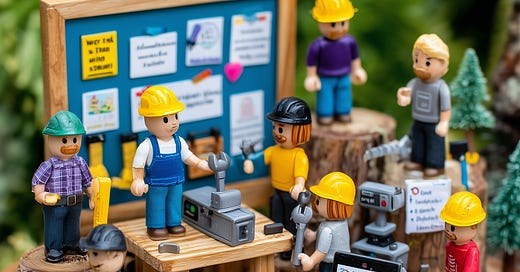In today’s fabrication industry, LEAN principles can sometimes seem complex or overwhelming, especially for small shops with limited time and resources. But when you keep it simple and focus on the essentials, LEAN becomes a powerful tool — delivering real value without unnecessary complication. At Green Shoe Garage, we’ve assembled a practical guide to straightforward LEAN strategies that even the smallest fabrication shops can use to work smarter, reduce waste, improve quality, and boost productivity.
Workplace Organization & Visual Controls
5S — A foundational LEAN tool for workplace organization:
Sort (Seiri) — Remove unnecessary tools, parts, and materials. Keep only what’s needed for current production.
Set in Order (Seiton) — Arrange tools, equipment, and materials logically. Designate specific locations so everything is easy to find and return.
Shine (Seiso) — Keep the workspace clean. Regular cleaning helps prevent issues, exposes problems early, and improves morale.
Standardize (Seiketsu) — Create consistent procedures for maintaining organization and cleanliness. Use checklists, schedules, or visual standards.
Sustain (Shitsuke) — Build good habits. Make 5S part of your shop’s culture through discipline and regular audits.
Shadow boards / tool control — Use outlined, labeled places for tools so missing items are immediately obvious.
Floor markings and zone labels — Clearly mark areas for raw material, scrap, WIP (work-in-progress), and finished goods.
Color coding / tags — Apply color schemes to tools, bins, and paperwork for fast identification.
Andon lights / status indicators — Simple lights or signals to display machine status (running, setup, down).
Job boards / work cell visual boards — Boards showing job priorities, schedules, and current progress.
Parts location labels & barcodes — Make it easy to find and track parts and inventory.
People & Communication
Daily standup meetings / huddles — Quick 5–15 minute meetings to review safety, goals, challenges, and daily plans.
Cross-training operators — Train team members on multiple machines or processes for flexibility.
Kaizen suggestion system — Provide an easy way for staff to suggest and act on improvement ideas.
Gemba walks (management at the work site) — Leadership regularly visits the floor to observe, listen, and support problem-solving.
Standard work instructions — Document best practices for setups, operations, and inspections — ideally with visual guides.
Job rotation (where safe) — Rotate tasks to reduce fatigue and build skills.
Production Flow & Scheduling
Single-piece flow / small batch production — Minimize work-in-progress, catch defects early, and keep the shop uncluttered.
Kanban pull systems — Use cards or bins to trigger replenishment only as needed.
Quick changeover / SMED — Reduce tooling/setup times so small batch production is practical.
Takt time awareness — Align production pace with customer demand.
Cellular manufacturing / work cells — Group machines to minimize part travel and boost efficiency.
Level loading / Heijunka — Balance workload to avoid peaks and valleys in production.
FIFO (First In, First Out) lanes — Ensure older jobs and materials are processed first.
Inventory & Material Management
Point-of-use storage — Keep tools and materials at the point of use.
Small lot purchasing / just-in-time delivery — Buy smaller quantities more frequently to reduce inventory costs.
Scrap bins at source — Identify and track scrap at the point where it occurs.
Standardized material handling equipment — Use carts and bins designed to fit your material sizes.
Mistake-proof labeling — Clear, consistent labels to prevent mix-ups.
Quality & Error Prevention
Poka-yoke (error-proofing) — Fixtures, guides, or checks that make mistakes impossible or immediately visible.
Go/no-go gauges or templates — Quick dimension checks without full inspections.
In-process quality checks — Find and fix issues during production, not just at the end.
Root cause problem solving (5 Whys, fishbone diagrams) — Structured methods to address recurring problems.
Standardized inspection points — Consistent checkpoints to catch defects early.
Equipment Reliability
Total productive maintenance (TPM) — Operators help maintain and clean equipment daily.
Preventive maintenance schedules — Planned maintenance to prevent breakdowns.
Simple machine downtime tracking — Log when and why machines stop to uncover patterns.
Waste Reduction & Continuous Improvement
Muda awareness training — Teach staff to spot the 7 wastes: overproduction, waiting, transport, overprocessing, inventory, motion, defects.
Kaizen blitz / improvement events — Focused efforts to solve specific problems quickly.
Value stream mapping (VSM) — Visualize and streamline processes by removing non-value steps.
Standard scrap and rework tracking — Identify sources of waste and address them.
Energy efficiency checks — Reduce wasteful use of energy, compressed air, and utilities.
Space utilization reviews — Reevaluate layouts to maximize efficiency.
Other Powerful LEAN Elements
Dedicated staging areas for incoming jobs
Clear scheduling boards or digital dashboards
Parts kitting (pre-package all parts needed for a job)
Checklists for setup, teardown, and cleaning
Dedicated rework/repair station
Visual timers or counters on processes
Invest time to build simple jigs and fixtures
Whiteboards to track jobs, ideas, and metrics
Digital tools (barcoding, QR codes) where practical
Final Thoughts
LEAN isn’t about expensive tools or complex systems — it’s about building a culture of continuous improvement through simple, disciplined practices. Small fabrication shops can achieve big gains by focusing on what matters most and involving the entire team in the journey.




